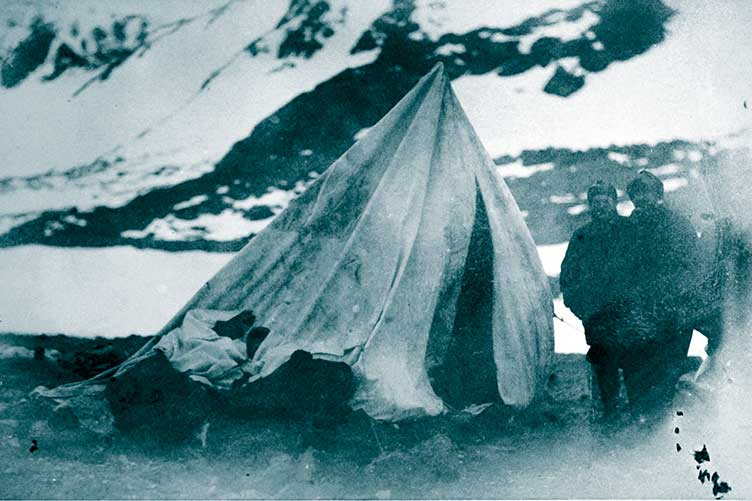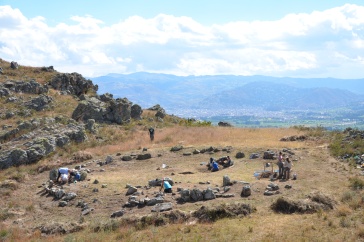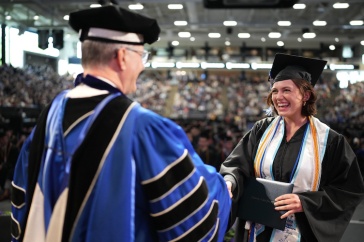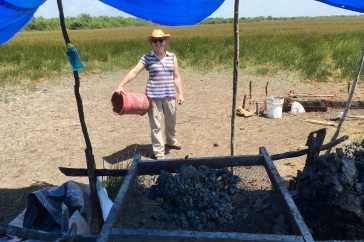
TRIUMPH TO TRAGEDY: An Arctic expedition led by Adolphus Greely in 1881 achieved "farthest north" and gathered thousands of scientific measurements. Rescuers, however, failed to arrive until 1884, when they found only a handful of survivors, near death, in a tent. (Photo: Ensign Harlow/Schley Relief Expedition, 1884)
Geoffrey "Jeff" Clark, M.D., '11G signed up for a UNH philosophy class just for fun toward the end of his career as a gastroenterologist. He had no idea it would lead to a master's thesis on a little-known Arctic expedition. Emma Baillargeon '09, on the other hand, knew at 22 exactly what she wanted to study: the performers in 19th-century freak shows. She also knew it wouldn't fit within the bounds of a single academic department. The Master of Arts in Liberal Studies program enabled both Clark and Baillargeon to design their own interdisciplinary degrees. Established in 1996 under founding director Paul Brockelman, a philosophy professor, the MALS program isn't for everyone. It requires a certain maturity, at any age, to chart one's own path through the academic maze. But students say the journey—whether undertaken on the way to a doctorate or just for pure enrichment—is well worth the effort. Clark's and Baillargeon's projects—as well as those of Kelly LaBrecque '08G and Andrew Bills '09—are highlighted here.
Abandoned in the Arctic

Geoffrey "Jeff" Clark, M.D., '11G
Thesis: "Arctic Ambitions"
Fields: History, American Studies, Photography
Current job: Retired Gastroenterologist
Trips to the Arctic: 3
Goal: Another project on the Greely expedition
When Adolphus Greely arrived in Portsmouth, N.H., in August 1884, he got a hero's welcome, complete with a parade and 20,000 spectators. He and the five men with him were the only survivors—out of a crew of 26—of a harrowing three-year Army expedition to the high Arctic. Just over a week later, however, a New York Times story revealed rumors of cannibalism and a government cover-up. The grisly reports were confirmed by an autopsy. In a century of imperialism, says Geoffrey "Jeff" Clark, M.D., '11G, Americans viewed themselves as superior to "savages" in other cultures and thus had to judge this act of desperation as a sign of moral depravity. As a result, says Clark, the man who was taunted as "Eat 'Em Alive" Greely has never received his due for his heroism and achievements.
Clark first visited the ruins of the expedition's Arctic camp 26 years ago. Since then he's devoted much of his own time, energy, and money—as well as his master's thesis in liberal studies—to the goal of bringing Greely's story to light. His efforts culminated in a 2007 documentary film that he produced, "Abandoned in the Arctic," in which Greely's great-great-grandson retraces the explorers' steps.
Greely and his team of explorers, based 500 miles from the North Pole, were charged with gathering scientific data and encouraged to set a new record for "farthest north." They succeeded on both counts, managing to take climate measurements several hundred times a day, around the clock, despite brutal conditions. (This data, ignored for more than 100 years, is now being used for research on climate change.) After Army ships failed to reach the explorers for two years, Greely led his team to a prearranged rendezvous 250 miles south. But no one was there to meet them, and the men had to endure a third Arctic winter with virtually no supplies or shelter. When rescuers arrived in June 1884, they found the few survivors barely conscious and near death in a collapsed tent.
For his master's thesis, Clark tracked down more than 100 photographs from the expedition as well as many of the crewmen's diaries. He is the first, since Greely, to have catalogued the photos, which had been taken with the then-new dry plate technology.

Andrew Bills ’09
Thesis: “Uploading Catholicism”
Fields: Communication, Religion, History
Current job: Staffing Coordinator and Substitute Teacher
Goal: Teaching, perhaps at the college level
Clark still gets choked up when he speaks of Greely's ordeal. And it's easy to see why. To watch the film, or even just to flip through the photos in Clark's thesis, is to be haunted—perhaps for a long time—by the sacrifices, accomplishments, and suffering of 26 men trapped in the cold and dark at the top of the world in 1884.
Vatican 2.0
One of the big stories of 2013 was Pope Francis' breakout success in the digital realm. In August, he made headlines with the first papal "selfie" photo. In November, the number of people following him on Twitter surpassed 10 million, placing him slightly below Kanye West and above The New York Times in popularity. But the Vatican hasn't always embraced the Internet. As with the introduction of radio and television in previous generations, says Andrew Bills '09, the Vatican initially cautioned Catholics about its dangers. His master's thesis in liberal studies will analyze the Vatican's use of the Internet to market the church to a younger, more global audience. "Here we have one of the most ancient institutions still standing, 2,000 years old, with more than a billion adherents," says Bills. "I think it's fascinating to see how they make sense of, and leverage, new technologies that they once feared."

Poster as Propaganda

of America, is in the grip of a blood-thirsty brute
representing the German Kaiser in this World
War I propaganda poster designed to convince
Americans to enlist (Image: Library of Congress,
LC - DIG - DS - 03216)

Kelly LaBrecque ’08G
Thesis: “Persuasion by Design”
Fields: Political Science, Art, Graphic Design
Current Job: Administrative Coordinator
Dream: To open a bakery
In 1917, Uncle Sam needed to sell the American public on going to war with the Germans, and fast. He didn't have TV. He didn't even have radio. But he did have more than 300 artists and illustrators—including Edward Hopper and N.C. Wyeth—who had volunteered to work without pay for the Committee on Political Information. The result, in the form of hundreds of thousands of propaganda posters, was "possibly one of the most successful advertising campaigns to have ever been launched," writes Kelly LaBrecque '08G, who has a bachelor's degree in political science and a certificate in graphic design. In her master's thesis, she evaluates the posters through the lens of graphic design. Some, she notes, are so heavy with text in different colors and fonts that they are confusing to the eye—and incomprehensible to the many Americans who couldn't read. A much more visual approach in "Destroy This Mad Brute" (left) effectively plays on fears of a German invasion, showing a blood-thirsty-brute-as-German-Kaiser heading straight for the United States, with a devastated France in his wake. This poster, which became very well known, may have helped inspire the 1933 movie "King Kong." But it was a different World War I poster—with its clarion call to action: "I Want You for U.S. Army"—that became known as the most famous poster in the world. That one belongs to Uncle Sam.
The Aristocrats
Charles B. Tripp, who was born without arms, managed to support his mother and sister by doing carpentry with his feet, until he joined P.T. Barnum's circus in 1872. "You could get a job if you were a freak back then," says Emma Baillargeon '09, "but you could make more money by being a freak." Between 1840 and 1930, many people with noticeable anatomical differences gravitated toward the museums, circuses, and carnivals where the freak show—the focus of Baillargeon's master's thesis in liberal studies—was considered a popular and legitimate form of entertainment. Some, including Tripp, who became known as the Armless Wonder, spent their entire lives performing. Others made a pile of money and settled down, like the conjoined twins Chang and Eng Bunker, from Siam (now Thailand), who bought land in North Carolina, married two sisters, and raised 21 children.

Baillargeon has found that freak show performers reaped more than just financial benefits. They found solidarity not only among their fellow freaks, but also within the tight circle of circus workers, who had their own lingo and code of behavior for dealing with outsiders, or "rubes." Shouting "Hey, Rube!" would immediately bring the entire crew to the defense of any co-worker who felt threatened.

Emma Baillargeon '09
Thesis: "Freaks: An examination of marginalized aristocrats"
Fields: Communication, Sociology, History
Current Job: Licensing Operations Specialist
Goal: Teaching at the college level
In high school, Baillargeon got a taste of what it's like be ostracized. She didn't fit in because she liked punk rock, but she made new friends at weekend concerts. "I found that I was marginal," she says, "but I found solidarity in that marginality." Her art teacher, Annette Blake '93, introduced her to the controversial work of Diane Arbus, who photographed "deviant and marginal" people. "Most people go through life dreading they'll have a traumatic experience," Arbus once wrote. "Freaks were born with their trauma. They've already passed their test in life. They're aristocrats."
It's a reality of the human condition, notes Baillargeon, that our bodies, and hence our social identities, are fragile. "At any moment we could easily become maimed and in turn, become a freak or disabled person, ourselves," she says, and part of what attracts us is seeing how others have "passed the test."
The stage name "Armless Wonder" captures both the loss of normalcy inherent in deformity and the triumph of succeeding not just in spite of—but because of—that loss. "Charles Tripp could do everything with his feet," says Baillargeon. "Thread a needle, drink a cup of tea. To me, that's what a 'freak' is—someone who conquers life."

















































